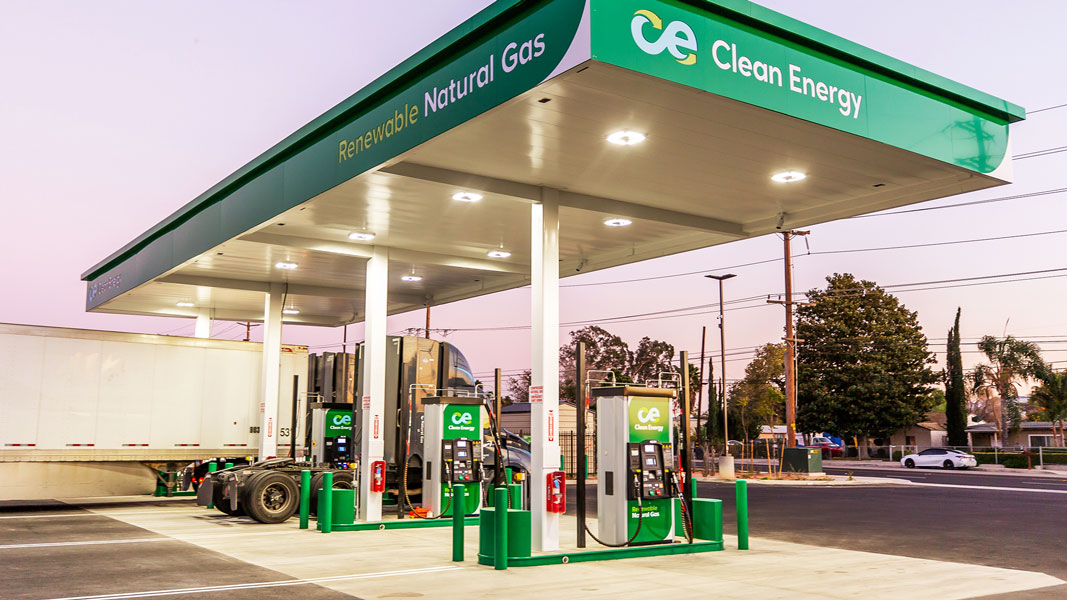Top: Clean Energy’s Renewable Natural Gas fueling station in San Bernadino, CA. Photo ©Scott Sporleder
The California Air Resources Board’s (CARB) Low Carbon Fuel Standard (LCFS) — implemented in 2011 — is designed to decrease the carbon intensity (CI) of California’s transportation fuel pool and provide an increasing range of low-carbon and renewable alternatives, which reduce petroleum dependency and achieve air quality benefits. The program works by requiring fuel companies to achieve CI targets by either producing lower CI fuel or purchasing credits from lower CI fuels sold in the California market. According to CARB, the system has generated $4 billion in annual private sector investment toward a cleaner transportation sector. Renewable natural gas (RNG) produced via anaerobic digestion of dairy manure is among the lowest CI fuels eligible for LCFS credits.
On November 8, CARB approved updates to the LCFS, setting targets to reduce the CI of California’s transportation fuel pool by 30% by 2030 and by 90% by 2045. The amendments also increase support for zero-emissions infrastructure, including for medium- and heavy-duty vehicles, and make more transit agencies eligible to generate credits. “The LCFS has been very effective to date, reducing the carbon intensity of California’s fuel mix by almost 13% and displacing 70% of the diesel used in the state with cleaner alternatives,” reports CARB. “This has displaced 320 million metric tons CO2 of gasoline and diesel emissions since the program’s inception. That’s an amount equivalent to 85% of today’s annual statewide greenhouse gas emissions.”
The updates include:
- Providing billions of additional dollars to fund zero-emission vehicle charging and hydrogen fueling infrastructure, including new crediting opportunities for medium- and heavy-duty refueling infrastructure, to support implementation of California’s zero emission vehicle regulations.
- Increasing incentives for infrastructure in low-income neighborhoods and remote locations and ensuring that historically underserved communities receive needed investment to reduce emissions and provide equitable access to a clean air future.
- Phasing out avoided methane crediting associated with the use of biomethane used as a combustion fuel, but extending the use of biomethane for renewable hydrogen to align with goals outlined in CARB’s 2022 Scoping Plan — the state’s plan for reducing climate-warming emissions and reaching carbon neutrality.
- Inclusion of new guardrails to avoid land use changes resulting in potential loss of food production or deforestation. The majority of biomass-based diesel and sustainable aviation fuel in the LCFS has historically come from waste feedstocks, such as used cooking oil, animal fat and inedible distiller’s corn oil. To minimize potential land use issues, the program will require fuel producers to track crop- and forestry-based feedstocks to their point of origin. The LCFS will also require independent feedstock certification to ensure biomass-based diesel and sustainable aviation fuel feedstocks are not undermining natural carbon stocks. Palm-derived fuels are explicitly prohibited from receiving credits.
The LCFS program currently limits the pass-through costs companies can shift to consumers by capping the price of credits that high-carbon-intensity fuel producing entities are required to purchase for compliance and allowing banking of credits bought at lower prices. Data from third party commodities markets experts shows the current LCFS pass through to California consumers is $0.10/gallon of gasoline, according to CARB, which reflects an LCFS cost pass through to consumers of $0.08 to $0.10/gallon of gasoline.
According to newly released data from the American Biogas Council (ABC), the biogas sector in California currently has a total of 383 operations that capture biogas, including anaerobic digesters and landfills. “[Biogas] facilities currently capture an estimated 167,329 standard cubic feet per minute (scfm) of biogas – equal to 87.9 billion standard cubic feet per year – with over half coming from landfills,” notes ABC. “Nearly one-third of California’s biogas capture systems have gone into operation since the start of 2020 and of these, 90% upgrade the raw biogas to renewable natural gas (RNG).













